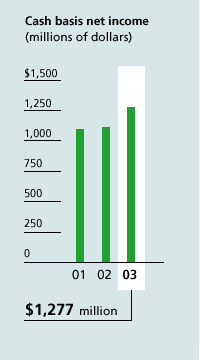|
|

|
Review of financial performance 2003Personal and Commercial Banking reported strong earnings growth in 2003 following modest growth in 2002. Cash basis net income of $1,277 million for 2003 increased by $163 million or 15% from the prior year. A three percentage point spread between revenue and expense growth, lower credit losses and a lower tax rate combined to improve earnings significantly year-over-year. Cash basis return on average invested capital increased to 18.5% from 16.8% last year as earnings growth exceeded the modest 4% increase in invested capital. Personal and Commercial Banking continued to drive growth in shareholder value by generating economic profit of $639 million during the year, an improvement of $201 million over last year after a one percentage point reduction in the rate charged for invested capital. Total revenue grew 2% in 2003 compared with the prior year. Solid real estate secured lending and deposit volume growth, higher transaction-based fees and strong growth in insurance income were the main contributors to revenue growth. Revenue growth was reduced by lower net interest margins, lower branch sales of Wealth Management products and a contraction in commercial lending volume. Personal lending average volume, including securitization, grew $7 billion or 7%, primarily from real estate secured lending, and personal deposit volume grew $4 billion or 5%. Business deposits grew by $3 billion or 13% and originated gross domestic insurance premiums grew by $295 million or 27%. Business loans and acceptances contracted by $1 billion or 6%. As of August 2003, our overall personal market share (loans, deposits and mutual funds) was 21.05%, slightly lower than the 21.25% in fourth quarter of 2002. We experienced modest market share declines in personal lending and personal deposits and increased share in mutual funds. Margin on average earning assets decreased from 3.42% to 3.28% due to a combination of rate environment, competitive pricing and customer preference. Core deposit margins narrowed from the impact of the low interest rate environment while competitive pricing has reduced margins on mortgages and term deposits. In addition, customer preference has weighted volume growth toward lower margin products such as the Guaranteed Investment Account and fixed-rate mortgages and home equity lines of credit. Credit quality improved over last year in personal lending and remained strong in small business and commercial banking. Provision for credit losses decreased by $45 million or 9% reflecting the continued improvement in retail lending processes. Provision for credit losses as a percent of lending volume improved to .36% from .41% last year. Cash basis expenses decreased by $38 million or 1% compared with last year. Expense synergies from branch mergers and from process improvements that were started following the branch and systems conversions in 2002 contributed to a 1,400 or 5% decrease in average full-time equivalent personnel over last year. The branch merger program is now complete with 32 mergers carried out during 2003 following 238 mergers over the previous two years. These savings in personnel costs were offset in part by increases in salaries and employee benefits, severance costs and variable expenses associated with strong volume growth in real estate secured lending and insurance products. In addition, up-front costs were incurred on the closure of 118 Wal-Mart in-store branches towards the end of the year. As a result of the actions taken to improve operational efficiency, the cash basis efficiency ratio for the year improved to 58.8%, two percentage points better than last year. Review of financial performance 2002Personal and Commercial Banking reported modest 2% growth in cash basis earnings in 2002 following strong growth in earnings during 2001. Total revenue grew 2% in 2002 compared with 2001. Core deposits, business deposits, credit cards and insurance were the main contributors to revenue growth. Growth in cash basis expenses was limited to 1% in 2002 compared with the prior year. Expenses in 2001 were impacted by costs associated with the conversion of the branch network and systems. During 2002, expense synergies were realized through branch mergers, however investments were made in customer service and process improvement initiatives following the conversions. Higher rates of expense growth were experienced in pension and benefit costs as well as in fast growing TD Meloche Monnex. The cash basis efficiency ratio for 2002 was 60.7%, an improvement of .8 percentage points over 2001. The provision for credit losses for 2002 of $505 million was $125 million or 33% higher than 2001. Approximately half of this increase was from small business and commercial lending returning to more normal loss levels following low losses in 2001. Losses in 2002 also included the impact of processing and collection issues that arose following conversion. |
 |